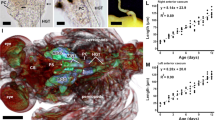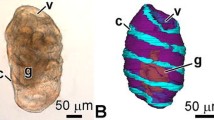Summary
The posterior midgut, the anterior hindgut and the caecum ofAlona affinis were studied by transmission electron microscopy. The caecum arises from the junction of the entodermal midgut and the ectodermal hindgut. It consists of gastrodermis and epidermis. Because of the ultrastructural similarity of the caecum with the posterior midgut and the anterior hindgut it is concluded that the caecum is a functional supplement of the latter gut parts. But the functional significance of these gut parts is poorly understood. Some ultrastructural features suggest that they contribute in excretion and salt regulation.
Similar content being viewed by others
Abbreviations
- Au :
-
autolysosome
- Ba :
-
bacteria
- Bl :
-
basal lamina
- Ca :
-
canaliculi
- Cae :
-
caecum
- Crc :
-
crypt cell
- Cu :
-
cuticle
- Ec :
-
epicuticle
- Ep :
-
epidermis
- G :
-
Golgi complex
- Hae :
-
hemolymph
- Hc :
-
head cell
- La :
-
basal labyrinth
- Lu :
-
gut lumen
- lMv :
-
long microvilli
- Mg :
-
midgut
- Mi :
-
mitochondria
- mC :
-
mitochondria rich cell
- nBc :
-
new border cell
- Nc :
-
neck cell
- Nu :
-
nucleus
- oBc :
-
old border cell
- Pc :
-
procuticle
- pMe :
-
peritrophic membrane
- pMg :
-
posterior midgut
- Rm :
-
ring muscle
- S :
-
secretion (? uncertain)
- sMv :
-
short microvilli
- vC :
-
vacuolated cell
References
Croghan PC (1958) The mechanism of osmotic regulation inArtemia salina (L.): The physiology of the gut. J Exp Biol 35:243–249
Coruzzi L, Witkus R, Vernon GM (1982) Function-related structural characters and their modifications in the hindgut epithelium of two terrestrial isopods,Armadillidium vulgare andOniscus asellus. Exp Cell Biol 50:229–240
Dall W (1967) The functional anatomy of the digestive tract of a shrimpMetapenaeus bennettae Racek and Dall (Crustacea, Decapoda, Penaeidae). Aust J Zool 15:699–714
Diamond JM, Bossert WM (1967) Standing-gradient osmotic flow. A mechanism for coupling of water and solute transport in epithelia. J Gen Physiol 50:2061–2083
Fox HM (1952) Anal and oral intake of water by Crustacea. J Exp Biol 29:583–599
Fryer G (1969) Tubular and glandular organs in the Cladocera, Chydoridae. Zool J Linn Soc 48:1–8
Fryer G (1970) Defaecation in some macrothricid and chydorid cladocerans, and some problems of water intake and digestion in the Anomopoda. Zool J Linn Soc 49:255–269
Geddes MC (1975) Studies on an Australien brine shrimp,Parartemia zietziana Sayce (Crustacea: Anostraca) — III. The mechanisms of osmotic and ionic regulation. Comp Biochem Physiol 51A: 573–578
Graf T, Michaut P (1980) Fine structure of the midgut posterior caecum in the crustaceanOrchestia in intermolt: Recognition of two distinct segments. J Morphol 165:261–284
Ito S, Winchester RJ (1963) The fine structure of the gastric mucosa in the bat. J Cell Biol 16:541–577
Mantel LH, Farmer LL (1983) Osmotic and ionic regulation. In: Bliss DE (ed) The biology of Crustacea, vol 5. Academic Press, New York, pp 53–161
Muramato A (1978) Relationship between anal intake of water and anal rhythm in the crayfish. Comp Biochem Physiol 61a:685–688
Musko IB (1986) Ultrastructure of epithelial cells in the alimentary canal ofCyclops vicinus vicinus Ulianine, 1875 (Crustacea, Copepoda). Zool Anz 217:374–383
Musko IB (1988) Ultrastructural studies on the alimentary tract ofEudiaptomus gracilis (Copepoda, Calanoida). Zool Anz 220:152–162
Mykles DL (1979) Ultrastructure of alimentary epithelia of Lobsters,Homarus americanus andH. gammarus, and crab,Cancer magister. Zoomorphologie 92:201–215
Ong JE, Lake PS (1969) The ultrastructural morphology of the midgut diverticulum of the calanoid copepodCalanus helgolandicus (Claus) (Crustacea). Aust J Zool 18:9–20
Oschman JL, Berridge MJ (1970) Structural and functional aspects of salivary fluid secretion inCalliphora. Tissue Cell 22:281–310
Smirnow NN (1974) Fauna of the U.S.S.R Crustaceae. vol 1, number 2, Chydoridae. Keter Publishing House, Jerusalem
Smith RI (1978) The midgut caeca and the limits of the hindgut of Brachyura: a clarification. Crustaceana 35:195–205
Smith WJ, Witkus ER, Grillo RS (1969) Structural adaptation for ion and water transport in the hindgut of the woodlouseOniscus asellus. J Cell Biol 43:135a-136a
Sullivan DS, Bisalputra T (1980) The morphology of a harpacticoid copepod gut: A review and synthesis. J Morphol 164:89–105
Talbot P, Clark WH, Lawrence AL (1972) Fine structure of the midgut epithelium in the develo** brown shrimp,Penaeus aztecus. J Morphol 138:467–486
Author information
Authors and Affiliations
Rights and permissions
About this article
Cite this article
Günzl, H. The ultrastructure of the posterior gut and caecum inAlona affinis (Crustacea, Cladocera). Zoomorphology 110, 139–144 (1991). https://doi.org/10.1007/BF01632870
Received:
Issue Date:
DOI: https://doi.org/10.1007/BF01632870




